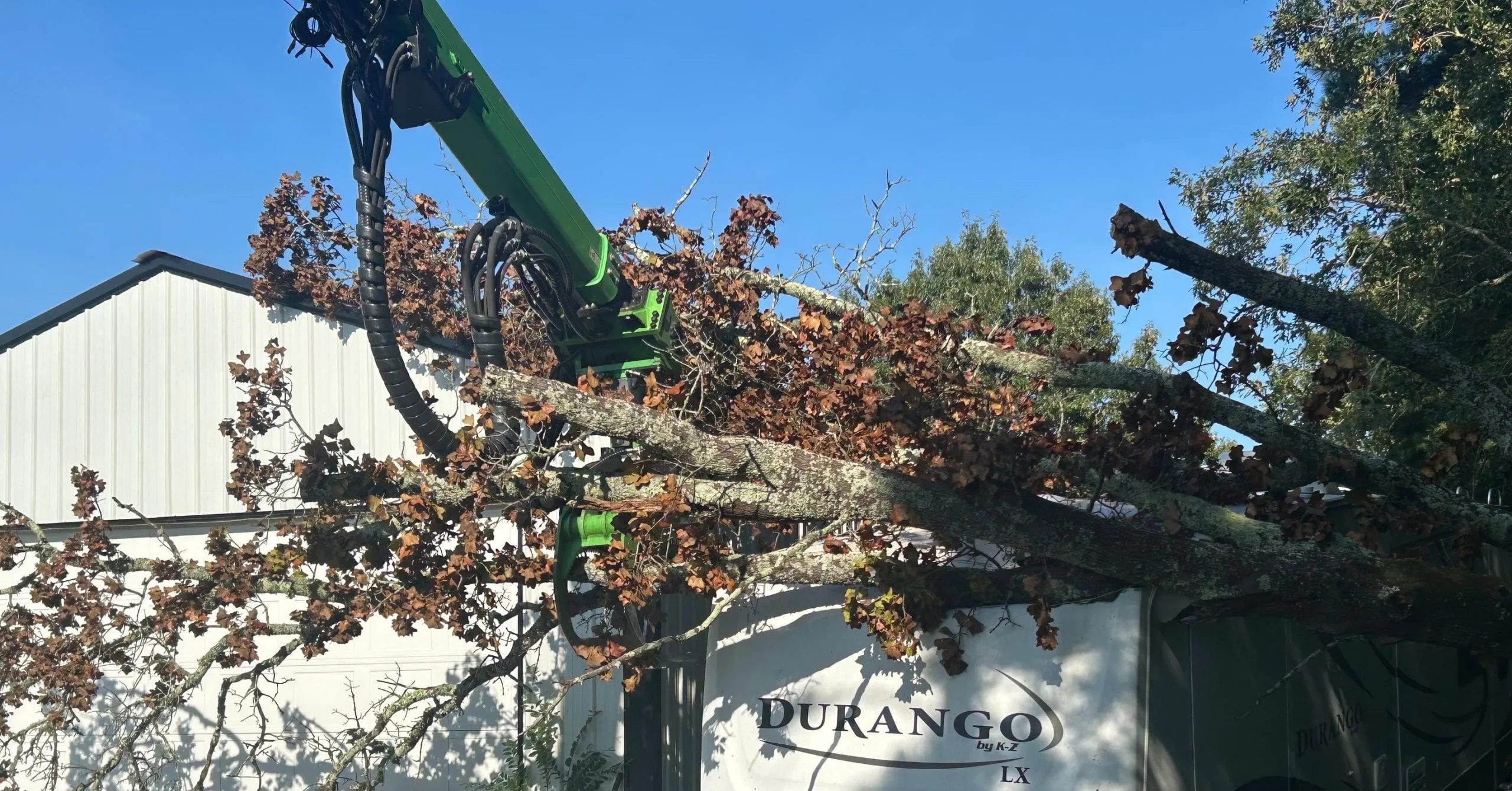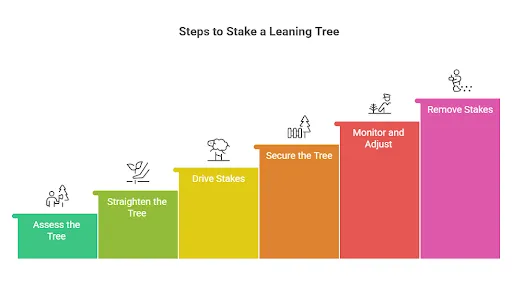
November 3, 2025
If you’ve just planted a new tree and a storm blows it sideways overnight, staking may be the difference between saving it or losing it. Young and newly planted trees sometimes struggle to stand upright on their own. High winds, heavy rains, weak root systems, or improper planting can cause them to lean. While mature trees often correct themselves as their roots anchor deeper, smaller or vulnerable trees may need support to grow straight and strong. Staking a leaning tree is one of the most effective solutions. Done correctly, it protects your tree from further stress while encouraging natural stability over time.
In this guide, we will explore everything you need to know about how to stake a tree that is leaning, when staking is necessary, when staking is not advised, common mistakes to avoid, and expert advice from Tupelo’s trusted professionals at Garrison McKinney Tree Service.
What is Tree Staking?
Tree staking is the process of using supports such as stakes, straps, and ties to help stabilize a leaning or newly planted tree. The goal is to give the tree enough support to remain upright while allowing natural root development and trunk strengthening.
Why is Staking Important for Leaning Trees?
- Stability in Early Growth: Staking prevents further leaning and damage during critical root-establishment stages.
- Protection from Weather: Strong winds and heavy rains in North Mississippi often push vulnerable trees off balance.
- Root Development: Proper staking encourages trees to grow deeper, stronger roots rather than depending on artificial support.
- Curb Appeal: Straight, healthy trees improve property appearance and value.
When Should You Stake a Tree?
Not every leaning tree needs staking. In fact, over-staking can harm development. Consider staking when:
- A tree is newly planted and top-heavy.
- Soil is too loose or sandy to hold roots firmly.
- High winds are common in your area, such as during storm season in Tupelo.
- The tree is leaning noticeably after planting or weather events.
If a tree has been in place for years and begins leaning suddenly, professional evaluation is essential, as this may signal root damage or disease.
When Not to Stake a Tree
- Avoid staking mature trees unless directed by a qualified arborist, as improper staking can damage established roots.
- Do not stake if the lean is minor and the tree shows signs of naturally correcting itself.
- Overuse of staking can weaken root development and reduce trunk strength.
Tools and Materials for Staking a Tree
- Wooden or metal stakes (6–8 feet long)
- Soft, flexible tree ties or straps (avoid wire or anything that can cut bark)
- Mallet or sledgehammer
- Scissors or pruners
- Protective gloves
- Reflective tape or paint for stake visibility
Staking Methods
- Single Stake: Best for small ornamental trees planted in calm areas.
- Double Stake: Two stakes on either side of the trunk, ideal for taller trees in moderate winds.
- Guying System: Three or more anchors with ties, used for very large, top-heavy trees or in extremely windy sites.
Step-by-Step Guide to Staking a Leaning Tree

Step 1: Assess the Tree
Check the extent of the lean. If roots are lifting from the ground, or if the soil is cracking around the base, call a professional arborist immediately.
Step 2: Straighten the Tree
Gently push the trunk upright. In some cases, watering the soil around the roots before adjustment helps reposition the tree more safely.
Step 3: Drive Stakes Into the Ground
Place stakes in firm soil outside the root ball area. Drive them at a 45-degree angle for maximum stability.
Step 4: Secure the Tree
Attach flexible ties or straps from the stakes to the trunk. Position them one-third of the way up the tree, never near the top. Ensure ties are snug but not tight. Some movement helps strengthen the trunk.
Step 5: Monitor and Adjust
Check ties every few weeks and especially after storms. Loosen or reposition as the tree grows to prevent girdling or bark damage.
Step 6: Remove Stakes at the Right Time
Stakes are temporary. Remove them before one year has passed or once the tree stands upright on its own. Always check tree stability before removal.
Key Benefits of Proper Tree Staking
- Supports young trees in harsh weather
- Encourages long-term strength and independence
- Reduces transplant shock
- Prevents damage to roots, trunks, and branches
Common Mistakes to Avoid
- Using Wire or Rope: These can cut into bark and damage the tree.
- Tying Too Tightly: Trees need natural movement to build trunk strength.
- Leaving Stakes Too Long: Extended staking weakens roots and trunk development.
- Improper Stake Placement: Stakes too close to the root ball can damage roots.
Best Practices and Expert Tips
- Always use wide, soft ties that spread pressure evenly.
- Stake on the side facing prevailing winds in Tupelo and North Mississippi.
- Inspect staking systems after major storms and adjust ties as needed.
- Water newly planted trees regularly and mulch to conserve moisture in Mississippi’s clay soils.
- Use reflective or painted stakes for visibility and yard safety.
- Live staking, a sustainable method using cuttings of living branches to stabilize areas, is an emerging eco-friendly trend.
- Seek professional advice for large, valuable, or heritage trees.
Staking Trees in Tupelo and North Mississippi
In North Mississippi, young trees often struggle with clay-heavy soils that loosen after heavy rainfall. Combined with the region’s frequent storms, this makes staking an essential part of new tree care. Homeowners in Tupelo regularly stake ornamental trees, fruit trees, and shade trees to ensure healthy growth and property protection.
Local Example
In 2023, several Tupelo homeowners planted ornamental cherry trees that leaned after strong spring storms. Garrison McKinney Tree Service provided expert staking, ensuring proper alignment and reducing stress on the roots. Within one season, the trees had stabilized and no longer needed support.
Future Trends in Tree Support
- Eco-Friendly Materials: More biodegradable ties and stakes are being developed.
- Smart Monitoring: Sensors are emerging to track soil stability and root growth.
- Preventive Landscaping: Strategic planting with windbreaks reduces the need for staking.
- Sustainable Techniques: Practices like live staking are gaining popularity.
Conclusion and Key Takeaways
Staking a leaning tree can mean the difference between a struggling plant and a thriving shade tree. The key is to use proper materials, provide just enough support, and remove stakes once stability is achieved. For homeowners in Tupelo and throughout North Mississippi, expert guidance ensures your trees receive the care they need to grow strong and beautiful.
For customized staking solutions, storm recovery services, and tree health evaluations, trust Garrison McKinney Tree Service. Schedule a consultation today and give your trees the professional care they deserve.
Frequently Asked Questions About Staking a Leaning Tree
What is the main purpose of staking a tree?
The main purpose is to stabilize young or leaning trees until their roots can anchor naturally.
How much does tree staking cost in Tupelo?
Costs vary depending on tree size and equipment. Simple residential staking may cost under $150, while larger trees requiring professional support may cost more.
Is staking necessary for every new tree?
No. Many trees adapt without staking. Staking is only recommended when soil, wind, or imbalance threatens stability.
How long should stakes remain in place?
Stakes should be removed before one year has passed. Remove them after the tree is stable to avoid root and trunk weakening.
Can I stake a mature tree that is leaning?
Mature trees that lean often have root or structural issues. Call a qualified arborist for professional evaluation.
What are the most common mistakes when staking trees?
Over-tightening ties, using damaging materials, leaving stakes in place too long, and failing to inspect after severe weather.
How is tree staking changing in 2025 and beyond?
Expect eco-friendly staking materials, improved monitoring tools, preventive tree care practices, and wider adoption of sustainable options like live staking.







